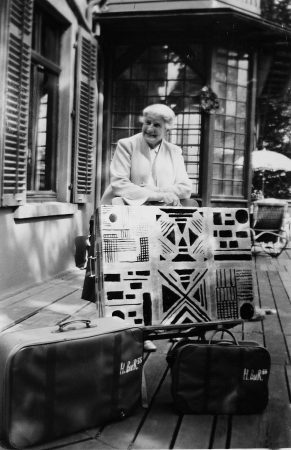Hanna Bekker vom Rath …
… Human Being and Artist (1953),
A small selection of attributes which introduced press articles about Hanna Bekker vom Rath since 1953 and beyond her death.
Art Dealer and Patron (1962),
Ambassador of the Arts (1964),
Enthusiastic Pioneer (1973),
Friend of the Muses (1984),
Cosmopolitan (1984)
From Enfant Terrible to Grande Dame (2013),
Friend and Patron of Artists (1985),
Guardian of “Degenerate” Art (2013),
Intrepid Collector (2013),
Patron Saint of the Ostracized (2013),
A Woman who Confessed Color (2018) …

before the one-year exhibition world tour, 1955
Photo Fridolin Frenzel
Hanna Bekker vom Rath (1893-1983) was an active painter, collector and patron of the arts in her Blue House in Hofheim am Taunus from the 1920’s on. She became a mediating “ambassador of art” since 1947 in the Frankfurter Kunstkabinett and worldwide.
A painter herself, she initially supported artists of her generation with Ida Kerkovius, Alexej Jawlensky and Karl Schmidt-Rottluff. During the National Socialist era, the Blue House became a refuge for ostracized artist friends. Her Berlin apartment developed into a clandestine meeting place for some “degenerate” artists and their supporters.
She has been in public since 1947, when she founded the Frankfurter Kunstkabinett Hanna Bekker vom Rath. As so-called Ambassador of Art, she introduced German artists worldwide and brought representatives of international art to Frankfurt.
The Hanna Bekker vom Rath Collection included works of German Expressionism as well as of younger artists. Hanna Bekker vom Rath lived and acted for the freedom of art as well as a mediator for people – artists and art lovers. A large part of the works of her collection are at the Museum Wiesbaden. Here and at the Stadtmuseum Hofheim, pictures of her hand are also regularly shown.
She herself, her work and her artistic connections continue to be honored in numerous exhibitions and events. A selection is continuously updated.
Top Image:
Photo Tita Binz, Hanna Bekker vom Rath (in front of Karl Schmidt-Rottluff, Nächtlicher Mittelmeerhafen, 1930 – now at Museum Wiesbaden), 1954
© Tita Binz / Deutsches Historisches Museum, © Karl und Emy Schmidt-Rottluff Stiftung Berlin, © VG Bild-Kunst, Bonn 2020